White Oak Farm
Market Goat Showmanship - 1/18/2012
by Carole Pontious on 10/31/13
By Phil Myers, IBGA Certified Senior Judge
*Editor's Note: Phil Myers has judged many shows from the county fair level to the national level throughout the entire United States.
The market goat project has been for years and remains one of the fastest growing youth projects through 4-H and FFA. Despite this fact, there are varying opinions and limited local knowledge in many areas of the country about preparing and showing wethers. What follows is a consensus of the opinions I have gathered from other judges and exhibitors across the United States at shows I have judged. My own experiences with goats and other species have also helped to form the subsequent article. As always, be sure to check on and adhere to the show rules of your own county, state, or independent show.
After selecting the wether or doe to be raised and shown and planning the feeding program, it's time to begin exercising the animal. The best way to break a goat to lead is using a traditional lamb halter. The goat's head is shaped differently than a lamb's so be sure to keep the cross of the halter slid well up the bridge of the nose to prevent cutting off its air supply. Using a halter to teach a goat to lead is done in order for the convenience of the individual who will be exercising it. The halter allows the young person to run with the goat much more easily than a chain, which is used for showing. Exercise should be started a minimum of 45 days prior to the show date to train the animal and firm up the muscle.
When the exercise program is commenced, also begin working with the goat to teach it to brace. The idea is to push the goat backward with the knee in the goat's chest to get the goat to push back. This is done to cause the goat to "flex" in human terms and give the judge a firmer handle. Bracing must be practiced in advance of walking into the show ring as most goats need to be trained not to simply back up. Unlike in a lamb show, the exhibitor should not necessarily brace his/her wether through the entirety of the class. Only when the judge is coming to handle must the wether be braced. When on a profile, it is up to the individual as to whether or not they prefer to brace. Some goats look better on a side view when they are pushing, while others do not. Remember that the front legs should always remain on the ground even when bracing for the handle. Most meat goat judges want the wethers braced but if the judge asks for them not to be, then comply. It's easier to show a wether without bracing that has been trained to rather than trying to teach one to brace 5 minutes before the class starts.
As the show approaches, hay can be removed from the regular diet approximately 7-10 days prior to the show. This gets the "hay belly" off which is critical in wether classes. Hay or roughage can then be fed on an as needed basis for fill. The animal should look filled out and fresh but without a big middle. Market goats need to be slick sheared 4-7 days before the show. The most efficient way to do this is with clippers that would be used for market lambs. Most fitters use Lister or Premier clippers with a "fine", "medium", or "cover cote" blade. Surgicals and Super-surgicals are too close. Leave the hair below the knees and hocks. The end of the tail can be squared off like a paintbrush. The shearing process should be preceded by a wash and dry job.
The actual show ring basics are the same for goats as with the other major species. Keep on the opposite side from the judge, set the feet out on the corners, and keep the head up. Those three things alone are about 80% of it. Dress code calls for jeans or slacks, a collared shirt, and boots or close-toed shoes. All white is not appropriate for showing market goats. Only outdated show officials and fairboard members still call for meat goat showman to participate in this dairy goat tradition. The goat should at all times be between the showman and the judge. Keep the head up and coming out of the top of the shoulder. Always move calmly and comfortably with or around the goat. John Wooden's famous quote of, "be quick, but don’t hurry" applies to setting feet. Set them quickly out on the corners each time you stop, but don't rush and look hurried. The front legs should be set slightly wider with a goat than they would be with a lamb. The rear legs should be set wider than the fronts and far enough back to get the goat's top down without stretching it too far. When the goat is set and the judge approaches to handle, let the chain slide down the neck and grasp the goat like a lamb with a hand on either side of its neck/head. After handling, pickup the chain and reset the feet.
Market goats should be shown with a chain. A nylon dog collar or leash is not an acceptable substitute for a serious showman. The chain should be long enough to allow the showman’s hand to easily fit between the chain and the head of the goat. However, the hand should be close enough to the head to maintain control of the animal. The flat chains with a hoop at each end that are intended to slip down themselves and choke the animal are not recommended. The best thing to do is purchase a metal dog chain at a local pet store or tractor supply. The "medium" or "fine" chains with the smaller links work well. Using pliers or bolt cutters, modify the chain to make one continuous circle with a few spiked links to go under the throat. These spikes distribute pressure more evenly and are actually more humane than the smooth chains. Adapt it to your own liking through trial and error.
The entire project should provide a fun learning experience and not become a drain on the youth. Goats have big personalities and are for the most part easily trained. With practice and a little perseverance, any junior exhibitor can achieve success with this project. Good luck this summer!
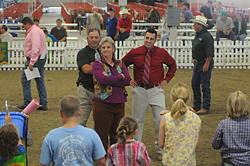
Pictured above right (red shirt) is Phil Myers judging the 2011 IBGA National Junior Show.
Hot Issue: How to Burn Horns on Goats - 1/16/2013
by Carole Pontious on 10/31/13
Perhaps the most frequently asked question we have at White Oak Farm is how to burn horns on wethers. While many Southern states have done away with this practice, it is still a common requirement in the Midwest. Unfortunately, many herd operations have not yet learned this skill causing concern on the part of the youth when horn regrowth exceeds the show’s guidelines. Then too, regrowth requires more evasive procedures and undue stress to the goat. Therefore, we would like to share our practices that we have found effective. Consult your veterinarian to see if these practices can help you, too.
We perform this task, when goats are two weeks of age. We wait until this time for two main reasons. One, the goats are old enough to tolerate the procedure. Two, it is the scheduled time to give the goats their CD & T vaccination. Since the CD & T offers tetanus protection, we feel this should be given at the same time that we burn horns.
We use a heavy duty dehorner to do the job. We allow it to heat up sufficiently for the task and allow for it to reheat between each dehorning. We first administer two (2) cc of the CD & T vaccination sub-q to the goat. A handler is helpful to restrain the goat. Make sure both you and your handler are wearing fire resistant gloves. We use welding gloves to protect our hands.
The dehorner is placed around the horn of the goat for ten seconds with steady even pressure. Make sure the dehorner covers the entire area around the horn. You will note a copper ring around the horn after the dehorner is removed. The key to this task is to remove the shell of the bud after you burn the horn. Caution: The horn is hot, so wear gloves to remove the bud. If you do not take the bud off, it will reattach and cause regrowth.
Allow the dehorner to warm up again before you do the same process to the second horn. After both horns have been removed, return to the first horn and apply the dehorner for eight (8) seconds to cauterize the area. With time, the hair will grow over the site and the animal will appear polled.

Equipment requirements include: dehorner, welding gloves, and CD & T vaccine.

A dehorner has been used on the left horn. Note the copper ring. The bud has not yet been removed.
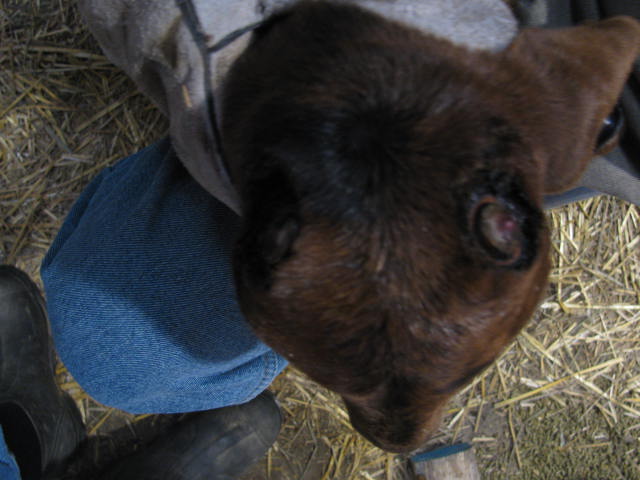
The goat is successfully dehorned and the area is cauterized.
Goat Therapy - 1/16/2012
by Carole Pontious on 10/31/13
From time to time, I stop and reflect why we are in the boer goat business. Our intent when we began this operation was to offer the kids a rich farming lifestyle, which we remember growing up with fondly. However, as the kids get older, we find that there are many other extra curriculars out there for young people.
Then, I realized something. The goat operation doesn’t necessarily have to be all about the kids. It can also bring a great deal of satisfaction to the adults.
Let’s call it goat therapy. In our busy lives, stress can consume us. We get wrapped up in meetings and phone conferences, which can really overwhelm us. Then, we go to the barn. The goats are so happy to see us. They chew on their cud blissfully. We find our breathing is calmer. We work off some pent up energy by tending to our herd. We enjoy the distraction it brings from the everyday world. And at the end of the day, we can nod off by counting goats not sheep.
Sure raising goats can be stressful, too. But make no mistake, goats can also take us away from the stresses of everyday life. I hope all of you can enjoy a little goat therapy today.
Air it All Out, Bloat in Goats - 1/19/2011
by Carole Pontious on 10/31/13
Perhaps the craziest thing we’ve seen recently on White Oak Farm is bloat. We have never seen this in the nine years we have raised goats, but on a routine visit to the barn we observed a lactating doe filled with air in her rumen the size of a basketball. We knew we had bloat because the enlarged side was on the left where the rumen is located.
We loaded the doe and her two doe kids in the trailer and headed to the vet on a brisk Sunday morning. The vet agreed it was bloat. He positioned a pvc pipe in her mouth and fed a rubber hose down her throat to her rumen. The pvc pipe was used so that the doe would not bite off the rubber hose. Once the hose entered her rumen, the vet asked me to palpitate the rumen to draw the gas out. The vet joked that one of his favorite “parlor tricks” is to light a match when the gas is released from the mouth. Talk about your flame throwers!
She was sent home with Bloat Treatment medicine by Butler Animal Health Supply, LLC. This is used as a drench at 20 cc twice a day. We have had to give it to her a couple more days since we had her at the vet. We are still not sure why she is susceptible to bloat. She is getting the same amount of feed as the rest of the does. Typically, bloat occurs with a change in ration or type of feed. Bacteria develop in the rumen creating the gas. The vet also suggested penicillin to combat the bacteria in the gut. This is just another example of the fun Boer goats can bring to a family!
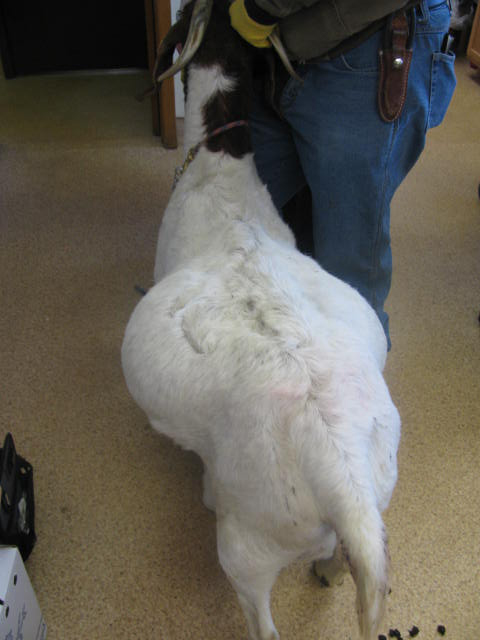
Doe exhibiting bloat observed by the swelling on left side where rumen is located.
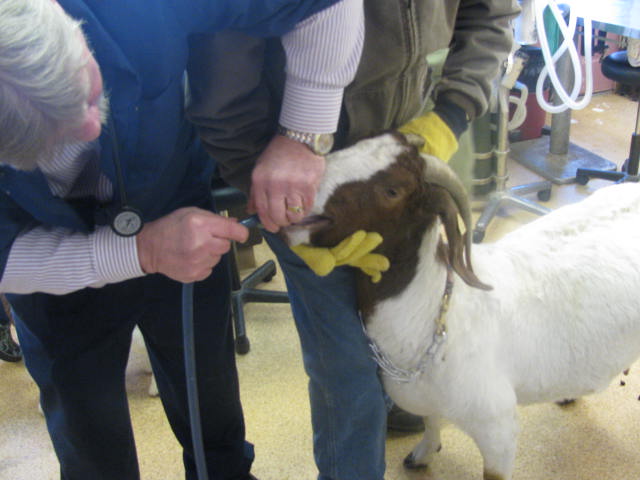
The vet feeds the rubber hose through the pvc tube in the mouth down into the rumen to release the bloat.
Kidding Season is here! - 1/7/2011
by Carole Pontious on 10/31/13
Kidding season can be one of the most exciting yet stressful times for us goat breeders. Often times the bulk of our kidding season in the Midwest occurs during the harsh winters. Preparation, then, is the biggest key to a successful kidding season. This starts well before kidding season and actually starts at breeding time.
At White Oak Farm, we keep a marking harness on the breeding bucks so that the buck will mark the doe when she is bred. We then record this information so we know when to expect her to kid. Does are maintained on pasture, free choice hay, water, and mineral until two months prior to kidding.
Two months before kidding the does are placed in groups depending on the overall condition of the goats and fed accordingly (i.e. the heavy does are placed in one group and the thinner does are placed in another group). If you have ultrasound equipment, you could group does based on the number of fetuses the does are carrying. This can be a cost effective management tool for breeders who can feed does carrying singles less to avoid kidding complications of large single kids, while feeding does with twins or triplets more to supply them with additional nutrition to support their pregnancies.
It is very important that pregnant does are on a worming program to control parasites. This is critical to a successful kidding season. We have found that regularly submitting stool samples from our herd to our veterinarian for analysis and then worming based on those findings has benefited our farm the most in controlling parasites. Note that I did not say eradicate parasites as this is impossible. Controlling parasites, however, is our best defense.
Another key to a successful kidding season is hoof trimming. Surprised? Actually, it makes a lot of sense. Does with healthy feet will exercise more and be more fit. As a result, the does are less likely to have kidding complications. This, also, greatly reduces the chances of pregnancy toxemia because the does are not carrying excess weight (see our related article Pregnancy Toxemia in Boer Goats).
One month before the does are to kid, they get their final worming. In addition, we often give the does ox tetracycline injection subcutaneously. This is an antibiotic to reduce premature births and related fetal health issues. I have been told the dosage is 5 cc per 100 pounds, but we do not give over 5 cc. We give it under the skin, because we found it can burn the does if given intramuscularly.
A word of caution to breeders using ox tetracycline, we have received reports that some does could abort from the stress of the injection, which is why we never give more than 5cc. As another alternative, some goat breeders will mix a soluble powder form of tetracycline in the herd’s water supply. Check with your veterinarian to see if this practice should be implemented in your herd.
Final preparations include gathering your kidding supplies. We like to have goat nutri-drench, iodine, Bo-se, CD & T, colostrum, feeding tube, and bottles with nipples on site. When the does are close to kidding, we check on the does every four hours to assist if necessary. At birth, we dispense 2 pumps of the goat nutri-drench to the kids which gives them a source of energy between the time they are born to the time they nurse. This allows the kids a chance to be cleaned off, warmed up, and further develop their instinct to suckle.
We have individual 4 x 6 kidding pens for does and their offspring after they kid. A safety zone for the kids allows them to be under a heat lamp without the doe bothering the heat lamp or accidentally laying on her kids. This is extremely beneficial in the Midwest during the winter kidding. This also gives the new family a time to bond. One-half cc (1/2 cc) of Bo-Se is administered to the kids within 72 hours of birth. We give two cc of CD&T to the kids at two weeks of age and six weeks of age. The kids are given their shots subcutaneously.
While kidding season is a stressful time, we greet it with excitement. We have learned that preparation throughout the year using proper management practices is key to a successful kidding season. Best of luck!
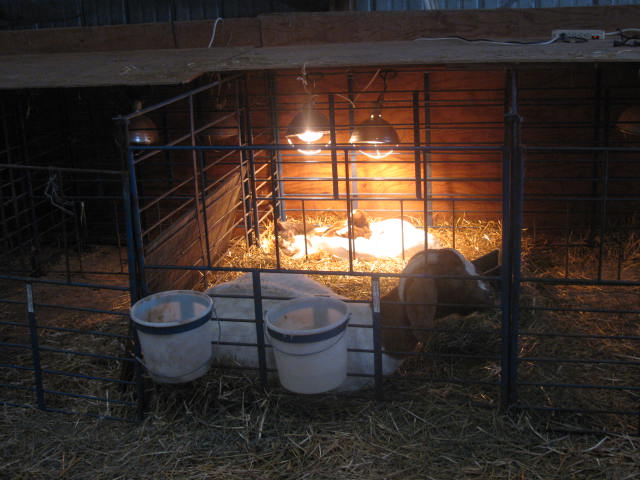
A doe rests in a kidding pen while her kids sleep in the safety zone area under protected heat lamps.
